AMAZON multi-meters discounts AMAZON oscilloscope discounts
1. Introduction
Power quality is generally evaluated in terms of harmonic content in both supply voltage and current.
For an ideal system, harmonics are typically caused by the use of nonlinear loads found in domestic equipment such as switch-mode power electronics converters, ballast for fluorescent lamps, computers, televisions, and other nonlinear loads used in tertiary and industrial applications such as power electronics operated adjustable speed drives, arc furnaces, and welding equipment. The nonlinear loads draw nonsinusoidal current from the network, an important harmonic content of the supply voltage with regards to the fundamental. The presence of such harmonics in the system can cause a number of unwanted effects for sensitive electronic loads such as industrial process controllers, hospital monitoring equipments, and laboratory measurement devices, and computers malfunction or fail to operate when connected to an ac line that has high harmonic voltage content. Also, electric utility transmission and distribution equipment may be susceptible to ac line harmonics. Furthermore, transmission lines, motors, and transformers could have higher operating losses; capacitor banks may fail due to over current, protective relays may not operate properly.
Generally, at the point of common coupling (PCC), the impact of the loads on the supply voltage can easily be measured and identified. Two types of harmonic-producing loads can be characterized at the bus bar that connects the supply voltage to different loads:
• Current type harmonics-producing loads; these loads are found as diode rectifiers and phase-controlled thyristor rectifiers feeding sufficient inductance connected to the dc side.
• Voltage harmonics-producing loads, such as diode rectifiers feeding sufficient filtering dc capacitors.
These two types of harmonic sources have completely distinctive dual properties and characteristics.
Based on their natural distinctive properties, both current and voltage type of harmonic-producing loads have their own suitable filter configurations.
Various mitigation techniques for reducing harmonics in the power system have been developed with time. Traditionally, passive filters such as low pass, high pass, band pass, and tuned filters have been used to eliminate low-order and high-order harmonics, and sometimes tuned filters are used to attenuate specific harmonics. Moreover, these filters contribute to the improvement of the power factor (PF), but their bulky size, limited compensation ability, and susceptibility to resonance with the source impedance constitute the major drawbacks of the technology.
Other industrial applications use power factor correction (PFC) devices for reactive power and current harmonics compensation. In these circuits, switched capacitor banks are typically connected in parallel to current-source-type loads. Seen from the load side, the capacitance of the PFC and the source inductor create a parallel resonant circuit. Looking from the source side, the PFC capacitors and the line inductor represent a series resonant circuit. To overcome the drawbacks of passive filters integrated with the PFC equipment, typical active power filter (APF) topologies may be used [5-6]. They are preferred over the passive filters because of their filtering characteristics and their capability of improving the system stability by avoiding possible resonance between the filter components and the mains impedance.
APFs have been known as an effective tool for harmonic mitigation as well as reactive power compensation, voltage regulation, load balancing, and voltage flicker compensation. They can be classified according to the converter type used (voltage source or current source); the number of phases (single-phase, three-phase application to three or four wires); and their topologies, which include shunt, series, hybrid, and unified-power quality conditioner (UPQC), which is a combination of series and shunt active filters. Shunt active filters are connected in parallel to electrical systems and can substantially improve current distortions, reactive power, load unbalance, and neutral current. It operates by injecting harmonic current into the utility system with the same magnitudes as the harmonic generated by a given nonlinear load, but with opposite phases. Unfortunately, it cannot compensate voltage-source type of nonlinear loads. In fact, lots of electronic appliances used in power system, such as frequency converters, switch-mode power supplies, and uninterruptible power supplies (UPSs) as well as electronic ballasts, etc., have a large filter capacitor on the dc side of the rectifier circuit.
They intrinsically belong to voltage-source nonlinear type of loads. The harmonics generated by such voltage-source nonlinear load can effectively be suppressed by using a series APF. Indeed, series active filters suppress and isolate voltage-based distortions such as voltage harmonics, voltage unbalance, voltage flickers, and voltage sags and swells. APFs have the capability of damping the harmonic resonance between an existing passive filter and the supply impedance, but they suffer from high kVA ratings. The boost converter constituting the shunt active filter requires a high dc-link voltage in order to compensate effectively higher order harmonics. On the other hand, a series active filter needs a transformer capable to withstand full load current in order to compensate for voltage distortion.
Combining the advantages of both passive and active filters, hybrid filter topologies are appealing.
They have been developed achieving the desired damping performance with a significant reduction of KVA effort required by the power active filter. They are cost-effective solutions to controlling voltage variations and distortions as well as suppressing harmonics. Passive filters are also used in this topology to carry the fundamental current component in a series active filter and the fundamental voltage component in a shunt active filter. UPQCs are the most effective devices to improve power quality. Its configuration consists of a series and a shunt active filter that usually share the energy source.
The series active filter cancels voltage harmonics and the shunt active filter cancels current harmonics.
Active filter systems have been also developed for dc/dc converters. These configurations of active filters are used for two purposes. The first purpose is to remove high-frequency electromagnetic interference (EMI) from input current of converter. The second reason is to remove the voltage ripple from the output voltage of the converter. Among all the configurations of active filters, UPQC is known as the best tool for power quality improvement. The latter is used to cancel both current-based and voltage-based distortions.
This chapter describes harmonic-producing loads, effects of harmonics on utility line, and harmonic mitigation methods, especially, passive active and also hybrid filters. Different topologies of active filters, their applications, configurations, control methods, modeling and analysis, and stability issues are detailed; moreover, simulation results are given to show the performance of every topology studied.
2. Harmonic Production and Characteristics
Harmonics are periodic voltages and currents signals having frequencies that are integral multiples of the fundamental frequency. In single-phase, 60 Hz power systems, odd harmonics such as 3rd, 5th, 7th, … are present on the ac side with the third harmonic being dominant, whereas even harmonics are found on the dc side. In three-phase three-wire, 60 Hz power systems, only non-triplen odd harmonics such as 5th, 7th, 11th, 13th, … are present. Harmonic distortion of supply voltage is caused because of the supply impedance and the presence of rich harmonic currents drawn by residential, commercial, and industrial loads such as switch-mode power converters, adjustable speed drives, elevators, electronic ballasts, air conditioners, arc welders, battery chargers, copy machines/printers, personal or mainframe computers, UPSs, silicon-controlled rectifier (SCR) drives, and x-ray equipment. The term total harmonic distortion (THD) gives the measure of harmonics content in a signal and is generally used to denote the level of harmonics present in the voltage or current signals. The quality of the energy became a major concern because of the recommended international standards such as IEEE-519, "IEEE Recommended Practices and Requirements for Harmonic Control in Electrical power Systems" and IEC-6002-3. The IEEE standard 519-1992 establishes the recommended guidelines for harmonic currents and voltage control in utility distribution systems. The standard specifies harmonics current and voltage limits at the PCC. The European harmonic standard, IEC-555, proposes absolute harmonic limits for individual equipment loads.
3. Characterization of the Disturbances
Several parameters are used in power systems to characterize distortion and harmonic content of a waveform and their effects: the PF, the THD, the distortion factor (DF), and the crest factor (CF).
The nonlinear load current iL is generally expressed by ....
Where:
ϕ1 is the phase angle of the fundamental load current
θs = ωt, ω is the frequency of the network
IL1 is the rms amplitude of the fundamental load current
ILh is the rms amplitude of the hth harmonic load current
ϕh is the phase angle of the hth harmonic load current
3.1 Power Factor
The apparent power, (volt-amperes), of a power system is given as ...
3.2 T otal Harmonic Distortion
The THD makes it possible to evaluate the difference between the real waveform and the sinusoidal waveform for the current or the voltage. It is used to quantify the levels of the current flowing in the distribution system or the voltage level at the PCC where the utility can supply other customers. It is defined as the ratio of the rms amplitude of harmonics to the rms amplitude of the fundamental component of the voltage or current as given in the following equation:
3.3 Distortion Factor
The DF is defined as the ratio between the rms value of the fundamental current and the rms value of the same current:
When the current is perfectly sinusoidal DF = 1, the latter decreases when the current is distorted.
3.4 Crest Factor
Another important quantity that characterizes the quality of the source current is the CF. The CF is the ratio between peak values to the total rms value of the same current:
For a sinusoidal waveform, CF is equal to 1.41. The peak factor can reach values higher than 4 and 5 for much distorted waves, especially for diode rectifiers feeding capacitive loads.
4. Types of Harmonic Sources
Nonlinear loads can generally be classified into two types, namely, voltage-source type of nonlinear loads (or voltage-fed type of harmonic-producing load) and current-source type nonlinear loads (or current-fed type of harmonic-producing load). These two types of harmonic sources have completely distinctive dual properties and characteristics. A voltage-source type nonlinear load may consist of loads like a diode or thyristor rectifier with a large smoothing capacitor at the load end. It is used in electronic equipments, household appliances, ac drives, and in power converters such as switch-mode power converters, UPSs, variable frequency drives (VFD), etc. Harmonics generated by these loads have become a major issue. The recommended types of compensating filters for this type of harmonic source are series passive, active, and hybrid filters (a combination of passive and active filters).
A current-source type of nonlinear load may consist of a diode or thyristor rectifier with sufficient inductance on the dc side such that it produces a constant direct current. It is used in applications such as dc drives, battery chargers, etc. The current at the input of the rectifier contains a large amount of harmonics due to the switching operation of the rectifier. It is recommended in [1] that for optimum harmonics compensation with these types of loads, parallel passive filters, active filters, and hybrid filters (a combination of the shunt or series passive and the shunt or series active filter) should be used due to the high dc-side impedance of the load that will force the compensating current to flow into the source side instead of the load side. Figures 1 and 2 show typical single-phase and three-phase current-source nonlinear loads. These bridge rectifiers feeding on the dc side an inductor:
LL = 10 mH in series with a resistor RL = 12 Ω.
The single-phase supply voltage (vs), the load current (iL), and its spectrum analysis are shown in FIG. 3. The measured THD of the load current is 11.31%.
The simulation results of the three-phase current-source nonlinear load are presented in FIG. 4. The supply voltage (vs1), the load current (iL1), and the spectrum of the load current in phase 1 are depicted in the same figure. The measured THD of the current generated by the nonlinear load is approximately 27.06%. The results show that the current contains a large number of odd harmonics. This distorted current causes a distorted voltage drop on the supply conductors, leads to voltage distortion in the supply systems, and results in poor power quality.
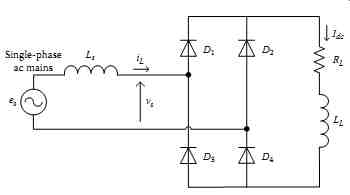
FIG. 1 Single-phase current-source type nonlinear load.

FIG. 2 Three-phase current-source nonlinear load.
Figures 5 and 6 show, respectively, single-phase and three-phase voltage-source type of nonlinear loads. These rectifiers are feeding a dc load constituted by a dc capacitor CL = 1000 μF connected in parallel with a resistor RL = 12 Ω. FIG. 7 illustrates the supply voltages (vs), the load current (iL), and the spectral analysis of the supply voltage and the load current. The THD of the supply voltage and load current are 9.45% and 115.98%, respectively. It is interesting to note that the load current contains a large amount of odd harmonics, with the third harmonic being dominant.
In FIG. 8, the supply voltage (vs1), the load current (iL1), and the spectrum of the supply voltage and load current in phase 1 are presented. One can notice that the THD of the supply voltage and the load current in phase 1 are 7.74% and 72.37%, respectively. It can be seen that the current and voltage waveforms of voltage-source nonlinear loads are much more distorted than those of the current-source nonlinear loads. This important distortion of the voltage is created due to discontinuity in the supply current.
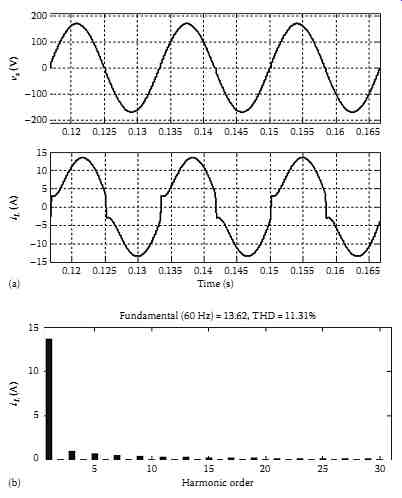
FIG. 3 Steady-state response of single-phase current-source nonlinear
load: (a) voltage and current waveforms and (b) spectrum of load current.

FIG. 4 Steady-state response of three-phase current-source nonlinear
load: (a) voltage and current waveforms in phase 1 and (b) spectrum of
load current.

FIG. 5 Single-phase voltage-source nonlinear load.
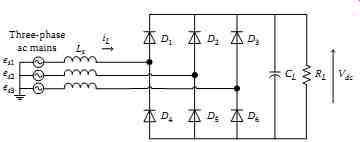
FIG. 6 Three-phase voltage-source nonlinear load.

FIG. 7 Steady-state response of single-phase voltage-source nonlinear
load: (a) voltage and current waveforms, (b) spectrum of load current,
and (c) spectrum of source voltage.
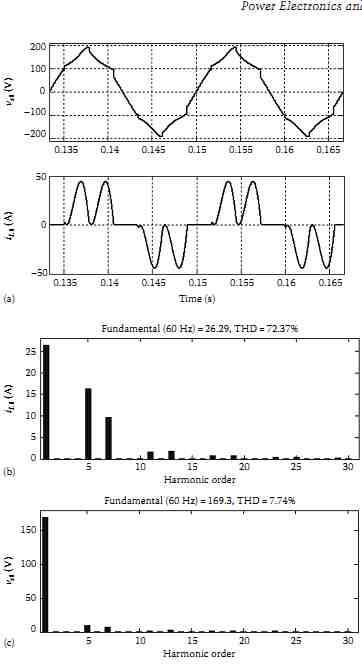
FIG. 8 Steady-state waveforms of three-phase voltage-source nonlinear
load: (a) supply voltage and current in phase 1, (b) load-current spectrum,
and (c) source-voltage spectrum.
5. Filters Used to Enhance Power Quality
Harmonic reduction is becoming more and more relevant due to the limitations required by interactional standards such as the IEC 1000-3-2 or EN61000-3-2 and IEEE-519. Several mitigation methods are available that permit substantial reduction of harmonics components. Different power filters have been installed in power systems to keep the harmonic distortion within acceptable limits. Conventionally, passive filters alone have been broadly used for harmonic mitigation; these devices have the advantages of being simple to design, not expensive to install, reliable, and require low maintenance efforts.
However, they have several drawbacks, such as large size, possible parallel and/or series resonance that could be created with both load and utility impedances, and filtering characteristics strongly affected by source and load impedances. To overcome the disadvantages of the passive filters, various types of APF have been developed to improve power performance. But, APF topologies suffer from high cost due to high KVA rating of the converter, and are less reliable. Hybrid active filters (HAFs) provide improved performance and have become a cost-effective solution to harmonic elimination, particularly for high-power nonlinear loads. The other alternative is the use of a UPQC to compensate voltage and current problem simultaneously. However, the use of UPQC is an expensive solution.
5.1 Passive Filters
Passive filters are combinations of inductors, capacitors, and damping resistors connected in series or in parallel to present the appropriate high or low impedance to the current or voltage harmonics. Various topologies of passive filter are available and have different compensation characteristics and applications.
They are generally used as shunt passive filters or series passive filters.
5.1.1 Shunt Passive Filters
The shunt passive filter is a series-tuned resonant circuit having low impedance at the tuned frequencies.
It can also provide limited reactive power compensation and voltage regulation. Single-tuned, first-order, second-order, and third-order high-pass passive filters are commonly used configurations.
Generally, one or more passive filter branches are designed for low-order harmonics and then one highpass filter is designed for the rest of the higher order harmonics. The shunt passive filter is very effective for compensating current-source nonlinear loads type of generated harmonics. These filters though quite useful pose various practical problems. The filter may create a series or parallel resonance with the source impedance resulting in the amplification of the harmonics with negative consequences. The frequency variation of the power system and tolerances in filter components affect its compensation characteristics. As a result, the size of the components in each tuned branch becomes impractical if the frequency variation is large. Overload occurs when the load harmonics level increases and consequently high current and voltages circulate in the passive branches; therefore, protection circuits are generally added to prevent such cases. Moreover, the supply impedance strongly influences the performance of the shunt passive filter, and since the source impedance may not be easily determined, the performance of the shunt passive filter becomes difficult to predict. Figures 9 through 12 show the most used passive filter configurations.

FIG. 9 Series-tuned second-order resonant branch (inductance, capacitance,
and resistance in series).
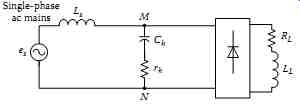
FIG. 10 First-order high-pass passive filter.

FIG. 11 Second-order high-pass passive filter.
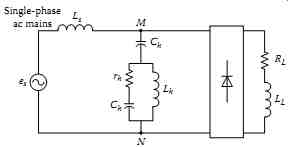
FIG. 12 Third-order high-pass passive filter.
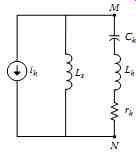
FIG. 13 Equivalent harmonic diagram seen as of points M and N.
The equivalent dynamic circuit of a series-tuned, second-order resonant branch at harmonic scale as seen between points M and N is shown in FIG. 13.
The source impedance is given by the following equation:
The quality factor (Q) of the passive filter, which is defined as the ratio of capacitive reactance (Xc) or inductive reactance (XL) to the resistance (rh) at tuned frequency, becomes infinite. Therefore, Q can be expressed as....
Where:
fh is the tuned frequency
C is the filter capacitance
L is the filter inductance On the other hand, the parallel impedance, also known as anti-resonance impedance, which can involve amplification and overvoltage at the frequency frh, can be expressed as in Equation 38.18a. The amplification factor depends on the quality factor of the filter:
Indeed, the decrease of the quality factor of the filter inductance reduces the overvoltage at the resonance frequency. Also, at the resonance frequency, the impedance is not null and the specific hth harmonic is not completely deviated. The ratio of the impedance after filtering to the impedance before filtering as a function of frequency when the resonant filter is tuned to fifth harmonic is given in FIG. 14.

FIG. 14 Compensation characteristic of series-tuned resonant circuit.

FIG. 15 Single-phase tuned shunt passive filter.

FIG. 16 Three-phase three-wire tuned shunt passive filter
To eliminate several harmonics, the idea consists in placing a tuned filter by harmonic. The elimination of k harmonics requires the parallel connection of k-tuned filters. In practice, each passive filter element employs three tuned filters, the first two being for the lowest dominant harmonics followed by high-pass filter elements. Figures 15 and 16 show the single-phase and three-phase tuned shunt passive filters. The ratio of the impedance after filtering with the impedance before filtering as a function of frequency when the resonant shunt passive filter is tuned at the fifth and seventh harmonic is given by FIG. 17.
5.1.2 Series Passive Filters
Series passive filters are constituted of parallel resonant branches connected in series with the nonlinear loads. They provide high impedance to the harmonic currents and prevent them from flowing into the power system. These filters also help reduce the current ripple on the dc side of the rectifier circuit.
They are of low cost, simple to implement, and have been used to limit harmonics caused by large loads. The series passive filters suffer heavily from lagging PF operation for a whole range of operation.
On the other hand, a finite small voltage drop across the finite inductive reactance and resistance of the coil occurs at fundamental frequencies due to the difficulty in designing sharply tuned filters, and large drop occurs at harmonic frequencies due to current at harmonic frequencies escaping from the block that has been created by these filters. The series passive filter has been found suitable for voltage-fed type of harmonic-producing loads. Generally, each series passive filter element employs three tuned filters, the first two being for the lowest dominant harmonics followed by high-pass filter elements. In each series passive filter element, two lossless LC components are connected in parallel for creating a harmonic dam to block harmonic currents. All the three components of the series passive filter are connected in series. Figures 18 and 19 show the general schemes of single-phase and three-phase series passive filters.
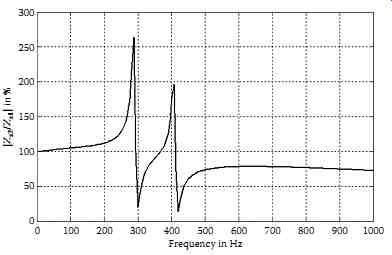
FIG. 17 Compensation characteristic of series-tuned shunt passive filter
that is tuned at the fifth and seventh harmonic.

FIG. 18 Single-phase series passive filter.
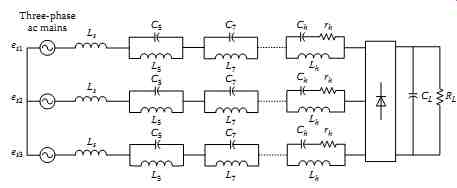
FIG. 19 Three-phase three-wire series passive filter.
5.2 Active Power Filter
To overcome the limitation of passive filters, APFs were developed to provide better dynamic control of current harmonics and voltage distortion control. This is achievable thanks to the developments in solid-state switching devices and control technology in recent years. APFs can be classified based by a number of elements in topology, supply system, and the types of converter used in their circuits. They are single-phase (two-wire), three-phase three-wire, and three-phase four-wire voltage- or current-source inverters used to generate the compensating voltage or current that is injected into the line. Current source active filters employ an inductor as the dc energy storage device. In voltage-source active filters, a capacitor acts as the energy storage element. Voltage source active filters are cheaper, lighter, and easier to control compared to current-source active filters. Several APF design topologies as illustrated in the block diagram shown in FIG. 20 have been proposed. They can be classified as follows: shunt active power filter (SAPF), series APF, hybrid shunt active filter, hybrid series active filter, and UPQC. They use PWM-controlled current-fed or voltage-fed converters with inductive and capacitive energy storage elements, respectively.
5.2.1 Shunt Active Power Filter
The shunt active filter operates by injecting harmonic current into the utility system with the same magnitudes as the harmonic currents generated by a given nonlinear load, but with opposite phases to maintain a sinusoidal current at the PCC. The major aim of the shunt active filter is to compensate harmonic currents yielding an improvement of the PF. It can also be used as a static var compensator in power system networks for compensating for other disturbances such as voltage flicker and imbalance. The SAPF offers some advantages such as the following: source-side inductance does not affect the harmonic compensation capability of the SAPF system, cost-effective for low to medium KVA industrial loads, can damp harmonic propagation in a distribution feeder, do not create displacement PF problems, and utility loadings. On the other hand, the APF topologies suffer from high KVA rating of the power electronic inverter for high-power industrial loads. This is due to the fact that the converter must withstand the line frequency, utility voltage, and supply harmonic current. In addition, it does not compensate for the harmonic in the load voltage. Figures 21 and 22 show a single-phase and a three-phase voltage-fed shunt active filter. A large capacitor connected to the dc bus of the converter behaves as a voltage source. A single-phase and a three-phase current-fed shunt active filter are shown in Figures 23 and 24. They use an inductive element for energy storage.
======
Active power filter Shunt active filter Current source inverter Voltage source inverter Series active filter Unified power Hybrid active filter quality conditioner Hybrid shunt active filter Shunt active filter in parallel with shunt passive filter Shunt active filter in series with shunt passive filter Hybrid series active filter Shunt active filter with series passive filter Series active filter in parallel with shunt passive filter Series active filter with series passive filter
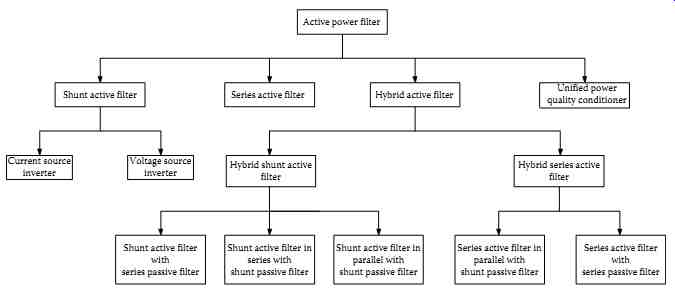
FIG. 20 Configurations of APF for power quality improvement.
======
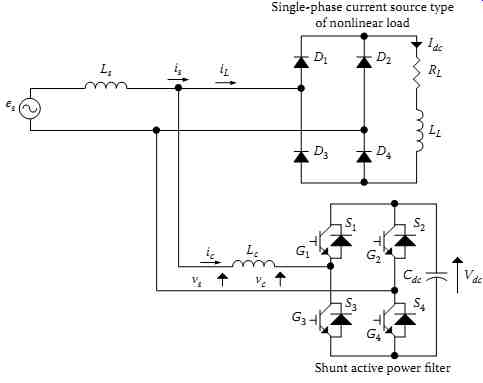
FIG. 21 Single-phase voltage-fed shunt active filter.

FIG. 22 Three-phase voltage-fed shunt active filter.
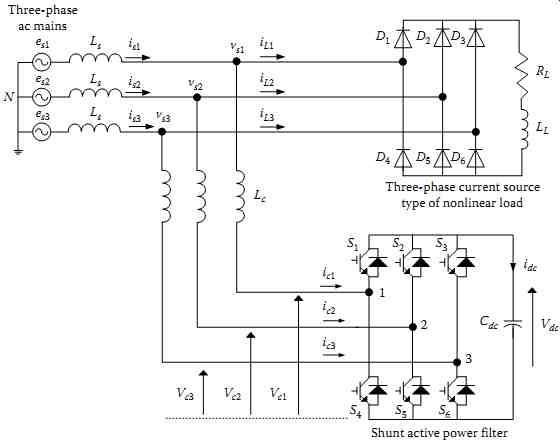
FIG. 23 Single-phase current-fed shunt active filter.
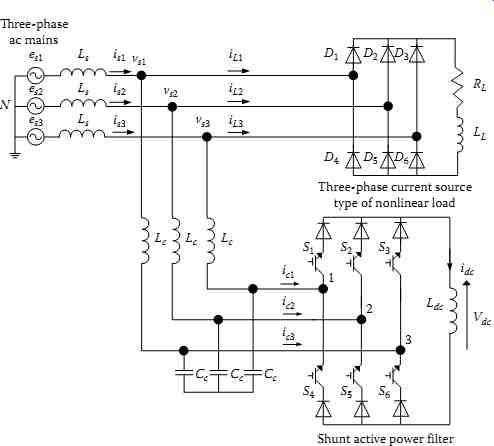
FIG. 24 Three-phase current-fed shunt active filter.
The inductor behaves as a controllable nonsinusoidal current source to compensate for the harmonic current requirement of nonlinear loads. A diode is used in series with the self-commutating device for reverse voltage blocking.
A four-pole switch type, a capacitor midpoint type, and a three single-phase bridge configuration of a four-wire SAPF are shown in Figures 25 through 27:
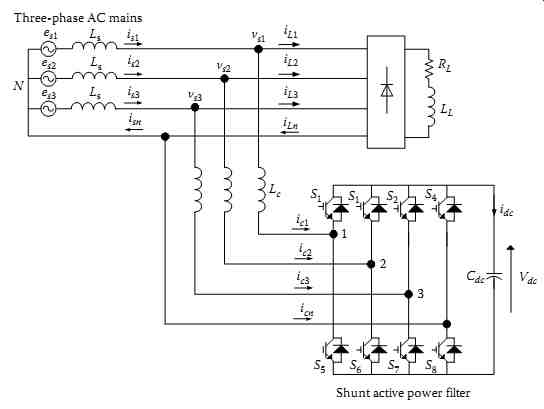
FIG. 25 Four-pole four-wire shunt active filter.
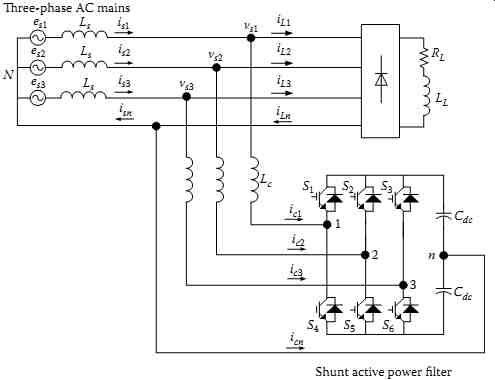
FIG. 26 Capacitor midpoint four-wire shunt active filter.
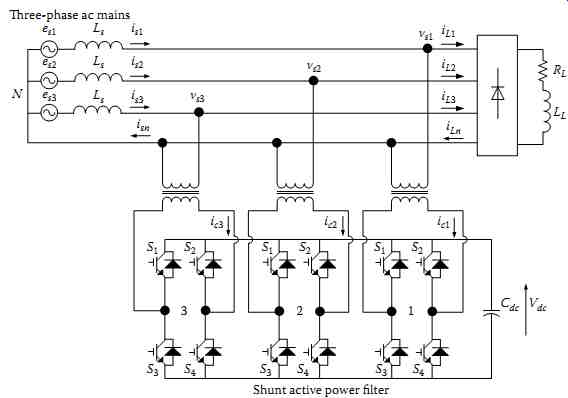
FIG. 27 Three single-phase bridge four-wire shunt active filter.
5.2.2 Series Active Power Filter
The series APF is connected in series with the utility system through a matching transformer so that it prevents harmonic currents from reaching the supply system or compensates the distortion in the load voltage. It is controlled in such a way that it can present zero impedance, at the PCC, to the fundamental frequency and high impedance to harmonic frequencies to prevent harmonic currents from flowing into the system. It injects the necessary voltage needed for compensation of voltage harmonics, voltage sags, and swells in dynamic voltage restoration, voltage flicker, and other voltage disturbances that distort the desired sinusoidal waveform at the PCC. It is also used to damp out harmonic propagation caused by resonance with line impedance and shunt passive filters. The series active filter is effective for compensating such voltage-source nonlinear loads. The function of the series active filter is not to directly compensate for the current harmonics of the load, but to isolate the current harmonics between the load and the source. A drawback to the series active compensator is its inability to directly compensate for current harmonics, balance the load current, suppress neutral currents, and compensate the reactive power. In addition, it carries full load current and must withstand large power ratings. In the event of a failure of the filter's transformer, the load will lose the power supply. Series active filters are designed either as controllable voltage sources (voltage-fed converter type) or as controllable current sources (current-fed converter type). A single-phase and a three-phase voltage-fed series active filter are shown in Figures 28 and 29. Figures 30 and 31 show a single-phase and a three-phase current-fed series active filter. FIG. 32 shows a three-phase four-wire voltage-fed series active filter.
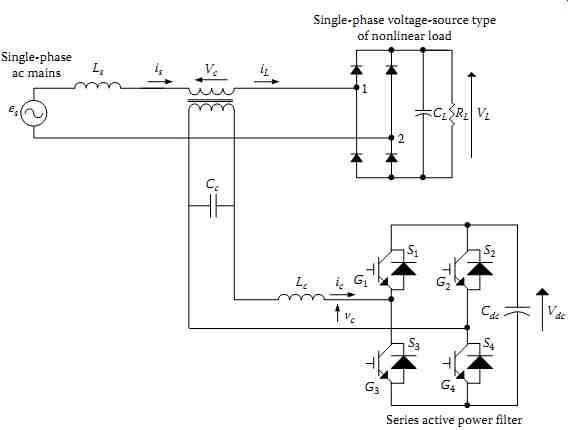
FIG. 28 Single-phase voltage-fed series active filter.
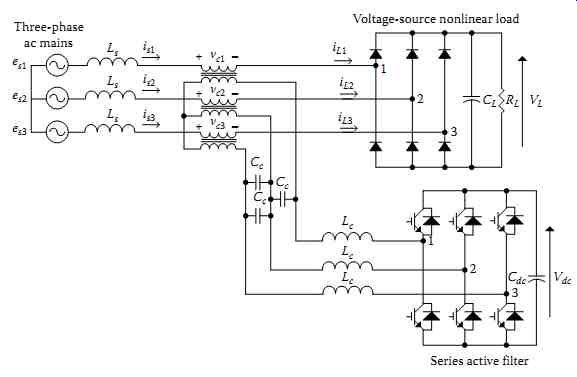
FIG. 29 Three-phase voltage-fed series active filter
5.2.3 Unified Power Quality Conditioner
The UPQC is a combination of series and SAPF, which are connected back to back and sharing a common self-supporting dc link. The series filter is controlled as a voltage source; hence, it is used for voltage compensation while the shunt filter compensates for harmonic currents. Hence, UPQC has the advantages of both the series and shunt filter, simultaneously. Although its main drawback is its high cost and complexity of control, interest in UPQC is growing due to its superior performance.
It can compensate significant power quality issues, such as, voltage harmonics, voltage sag, voltage swell, voltage unbalance, voltage flicker, current harmonics, load reactive power, current unbalance, and neutral current. A single-phase voltage-fed and current-fed UPQC are shown in Figures 33 and 34. Figures 35 and 36 show the schematic of a three-phase three-wire and a three-phase four-wire UPQC.

FIG. 30 Single-phase current-fed series active filter.

FIG. 31 Three-phase current-fed series active filter.

FIG. 32 Three-phase four-wire voltage-fed series active filter.

FIG. 33 Single-phase voltage-fed UPQC.

FIG. 34 Single-phase current-fed UPQC.
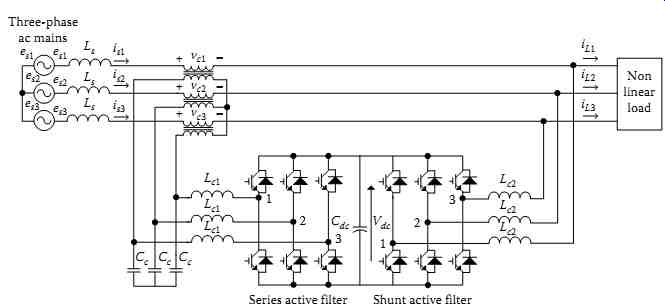
FIG. 35 Circuit configuration of a three-phase three-wire voltage-fed
UPQC.
5.2.4 Hybrid Filters
APFs have the capability of damping harmonic resonance between an existing passive filter and the supply impedance, but they require a large current rating with low efficiency and harmful disturbance to neighborhood appliances. HAF topologies that combine the advantages of both active and passive filters are more appealing in terms of cost and performance. They are cost-effective by reducing the KVA rating of the active filter as much as possible while offering harmonic isolation and voltage regulation. Two types of HAFs have been developed: a shunt HAF and a series HAF. The shunt hybrid filters consisting of shunt active filter and shunt or series passive filters connected in series or in parallel with each other combine the advantages of both filters. This is an attempt to reduce the high KVA rating of the shunt active filter without compromising its functions. A single-phase and a three-phase shunt HAF are shown in Figures 37 through 42. The reduced switch hybrid filters along with load arrangement are shown in Figures 38 and 40. Since one leg of the active filter is eliminated by a center tap capacitor, the gate drive circuit requirement and associated electronic circuit including the number of current sensors are eliminated. Thus, these topologies reduce the overall cost of the system. Figures 43 and 44 show the schematic of a three-phase series hybrid filter. The series hybrid filter is a series or parallel combination of a series active filter and series or shunt passive filter. The series active filter acts as a harmonic "isolator." It is to improve the filtering characteristics and to solve the problems of the passive filter. Hence, the rating of the series active filter is much smaller than that of a conventional parallel active filter.
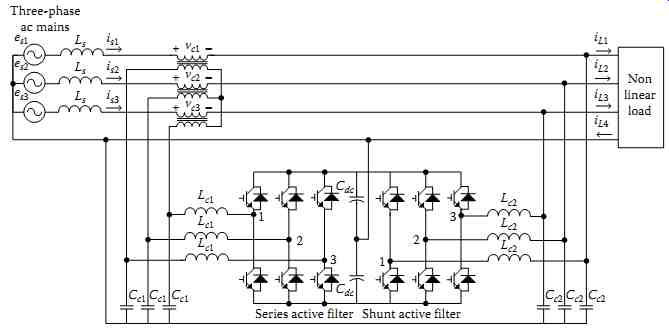
FIG. 36 Circuit configuration of a three-phase four-wire voltage-fed
UPQC.
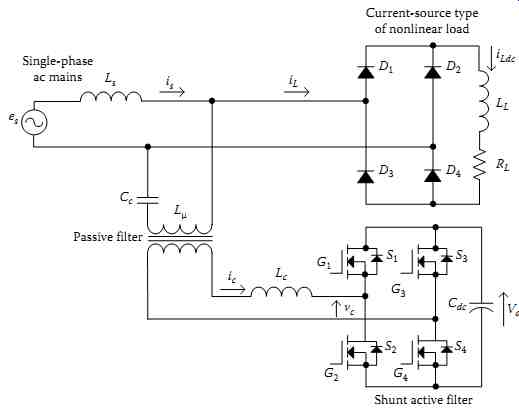
FIG. 37 Single-phase voltage-fed shunt hybrid filter.
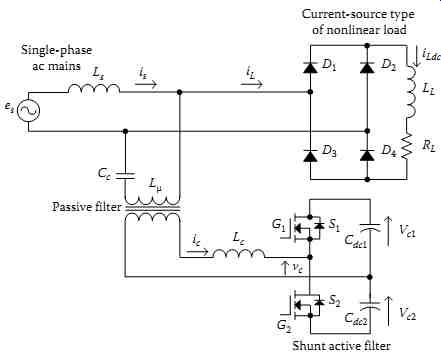
FIG. 38 Single-phase voltage-fed reduced switch shunt hybrid filter.
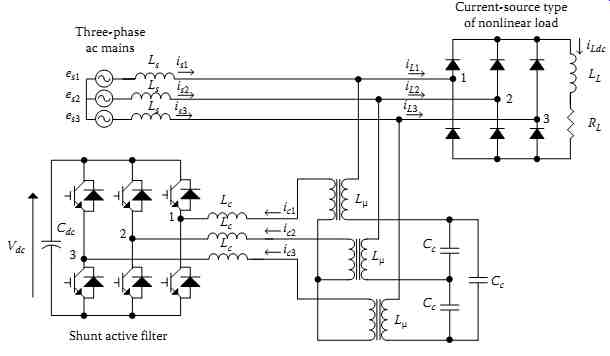
FIG. 39 Three-phase three-wire voltage-fed shunt hybrid filter.

FIG. 40 Three-phase three-wire voltage-fed reduced switch shunt hybrid
filter.
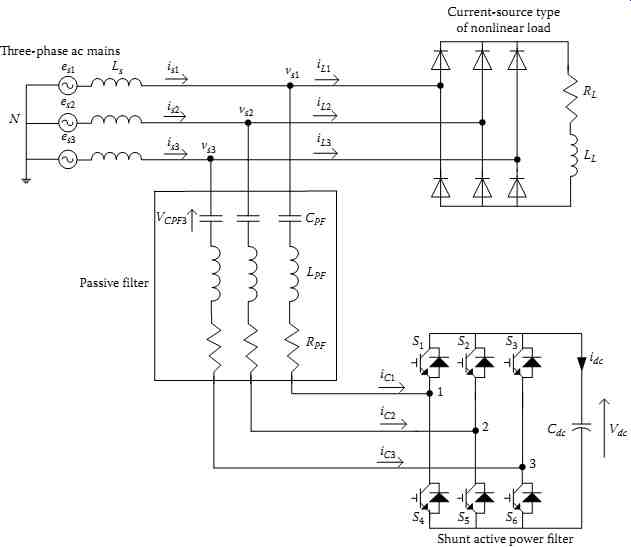
FIG. 41 Three-phase three-wire voltage-fed shunt hybrid filter.
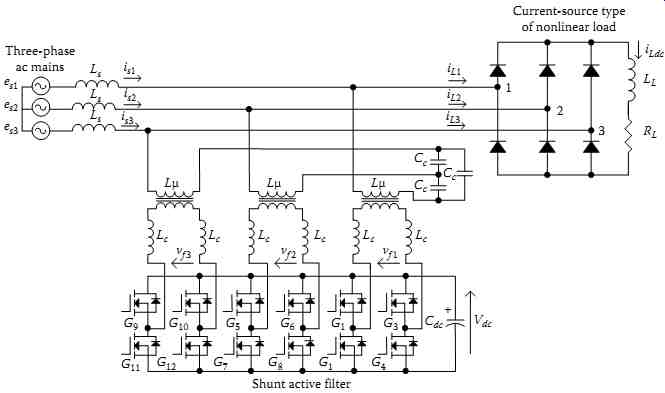
FIG. 42 Three single-phase bridge three-wire voltage-fed shunt hybrid
filter.
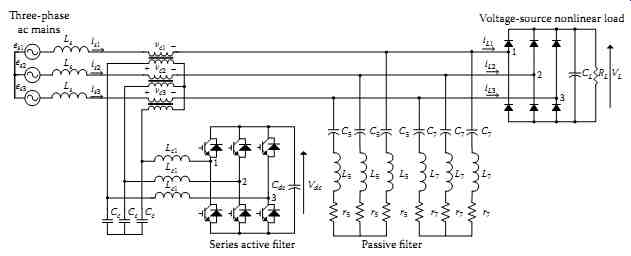
FIG. 43 Three-phase three-wire voltage-fed series hybrid filter.
6. Control of Active Filters
The quality and performance of the APF depends partly on the modulation and control method used to implement the compensation scheme. Several control strategies can be used to regulate the current produced by the filter: variable switching frequency, such as hysteresis and sliding-mode controls allow direct control of the current, but make the design of the output filter quite difficult as well as the reduction of the noise level. PWM control eliminates these problems, but the dynamic response of the current feedback loop reduces the ability of the filter to compensate for fast current transitions. Many algorithms in time and frequency domains are proposed to extract or estimate compensating harmonic references for controlling the APFs. The most popular are the time-domain methods such as the notch filter, the instantaneous reactive power theory (IRPT), the synchronous reference frame (SRF) theory, high-pass filter method, low-pass filter method, unity PF method, sliding-mode of control, passivity based control, proportional integral (PI) controller, flux-based controller, and sine multiplication method. The main advantage of these time-domain control methods compared to the frequency-domain methods based on the fast Fourier transformation (FFT) is the fast response obtained. On the other side, frequency domain methods provide accurate individual and multiple harmonic load-current detection.
The discrete Fourier transform, the Kalman filter, and the artificial neural networks are the most harmonic estimation techniques. There are two control techniques used to generate switching signals for APFs, namely, the direct and the indirect control techniques. The direct method detects harmonics in the loads and injects current through an active filter to cancel the harmonics. On the other hand, the indirect method senses the harmonics in an ac network, and injects harmonic currents using feedback control to reduce the harmonics. It has been demonstrated that the direct method is not robust enough when the time delay in the control circuits is considered, and the indirect method is more reliable. Indeed, in the literature, it was reported that the current-type nonlinear load exhibits a step wave shape, and there is an instantaneous change from one step to another. This requires instantaneous compensation, but the inherent delay in the compensation using direct current control scheme results in switching ripples in the supply current. It is also essential to find why the direct control algorithm of APF suffers from this problem of switching ripples. The reference APF current are fast varying nonsinusoidal signals and the direct current control algorithm works on the principle of feed-forward control, where, the reference current of the APF is compared with its sensed current. Therefore, at a point in the ac cycle, the direct current controller does not have accurate information about the shape of the actual (sensed) supply current. Therefore, even if there are switching ripples in the supply current, the direct current controller does not compensate the ripples due to lack of exact information.
Section 7 addresses the analysis of the single-phase shunt active power filtering scheme with two control techniques. Direct and indirect current control techniques are presented with the use of a unipolar PWM (U-PWM) and a bipolar PWM (B-PWM) applied to the single-phase shunt active power filter (SPSAPF) to compensate the current harmonics and the reactive power. It is demonstrated that by using the averaging technique, the direct consequence of using the U-PWM is that the transfer function of the SPSAPF becomes a pure gain, which simplifies the tuning of the regulator parameters. Also, the U-PWM pushes back the first significant harmonic rays toward twice the switching frequency 2fsw. Furthermore, it eliminates the rays groups that are centered on the odd multiples of the switching frequency. In addition to the current compensation loop, a voltage loop is also designed in order to regulate the dc bus voltage and to stabilize it at a designed value. The current and voltage regulators are designed by applying the linear control theory on a small-signal frequency domain model of the filter. This mathematical model is derived by using the state-space average modeling technique and, then, applying the small-signal linearization process.
The SPSAPF is analyzed based on effective THD levels and response to changing dynamics. The results concerning the two PWM control techniques are verified by simulation, and experimental results on a 1 kVA prototype obtained using the direct and indirect current control strategies confirm the predicted performance and the superiority of the indirect current control technique with the U-PWM.